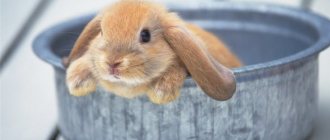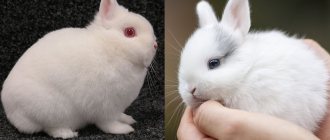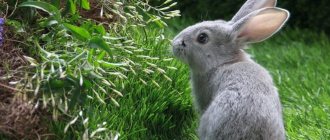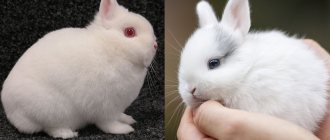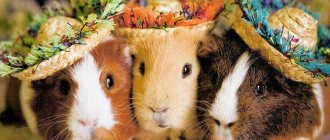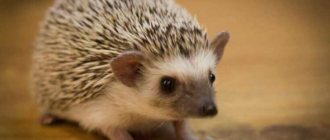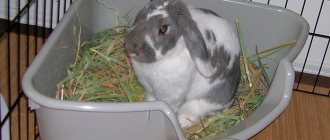If you want to buy a pet similar to a hamster or guinea pig, but are afraid that they have a low life expectancy, opt for decorative rabbits! The animals are very cute and beautiful, they live on average 6-9 years, with good care and up to 12 years. Rabbits are easy to care for, they are funny and will bring you a lot of joy.
There are many breeds of rabbits, including short-haired dwarf rabbits, weighing only 1-1.5 kg with short ears and a small body. This is the Angora dwarf rabbit. Their fur is quite long, it can cover their eyes, and it needs to be trimmed periodically. There are also funny lop-eared sheep rabbits; their ears do not stand up like those of ordinary rabbits, but hang down on the sides, which gives the animal a very charming appearance. The basic principles of caring for all rabbits are similar, and we will discuss them below.
What do rabbits need?
What do you need to buy to keep a rabbit at home?
- Cage, enclosure for puppies. The cage must be at least four times the size of the future occupant. ...
- Little house. A cozy, secluded place to relax and sleep.
- Tray. ...
- Filler. ...
- Bowls. ...
- Nursery for hay (hay barn). ...
- Chew toys. ...
- Mineral stone.
Interesting materials:
What does a pheasant like to eat? Which is better: wood flooring or laminate? Which is better DVI DVI or DVI HDMI? What is better Eurodvushka or one-room? What's better: cardio or strength training? What is better: a cabinet or a built-in wardrobe? What is the best thing to eat before training? Which is better, raspberries or blackberries? What is better wallpaper or gesso? Which is better, push-ups or planks?
Contents in the apartment
Rabbits do not require special care, and the principles of caring for a pet are not difficult. Figuring out how to keep a rabbit in an apartment is not difficult.
Important! Please note that the rabbit is a nocturnal animal. The peak of its activity will occur in the evening; during the day the animal either sleeps or rests. If your sleep is easily disturbed, do not place your pet's crate in the bedroom. It is also very easy to frighten a rabbit, and in a state of panic, the animal can even injure itself. Watch your movements and actions when communicating with him, avoid loud sounds. Do not place the cage in the kitchen or busy areas.
Health
Rabbits by nature have poor immunity and often get sick. Animals tolerate infectious diseases the worst.
One of the most dangerous diseases is myxomatosis. The disease is incurable; it can only be prevented through preventive vaccination. If a rabbit gets sick and the vaccine has not been given, it must be immediately euthanized and the body burned. Symptoms of myxomatosis are swollen eyelids, ears, genitals, conjunctivitis. Bald patches and sores may occur in the affected areas of the skin.
Another dangerous disease is coccidiosis. The disease poses the main threat to small rabbits up to 3 months old. Symptoms: bloating, poor appetite. Choosing quality food and clean drinking water will help protect against disease.
Rabbits live for about five to seven years, but in the right living conditions the animal can live up to 12 years.
Possible diseases
Decorative breeds of rabbits have weak immunity. They can get sick and die even from fright. That's why you should be attentive to their health. What do they suffer from:
- Infectious diseases. These include pasteurellosis, myxomatosis, coccidiosis, rhinitis, ringworm, stomatitis.
- Parasitic diseases (invasive). These include helminthic infestations, psoroptosis (scabies), and fleas.
- Non-communicable diseases. These include injuries, frostbite, colds, overheating, mastitis, poisoning, digestive problems, flatulence, pododermatitis, eczema.
Let's look at the general signs of illness, if you notice them you should contact a veterinarian:
- runny nose, sneezing;
- tearing, purulent discharge from the eyes, swollen eyelids;
- wet face;
- teeth grinding;
- loss of appetite or refusal to eat or drink;
- bloating;
- lack of feces or diarrhea;
- bumps on the body, head, spots on the skin.
- hair loss in clumps, bald spots;
- depressed look;
- tousled, unkempt fur;
- rapid breathing.
Any of the following symptoms may indicate a rabbit is sick. You should not hesitate to discover them because these animals can die quickly.
Having decided to get a decorative rabbit, you should carefully weigh everything, because it requires a lot of attention. It is important to keep the cage clean, provide him with adequate nutrition, care for his fur and claws, and treat him if a disease is detected. All this requires not only time, but also certain material costs.
A tame domestic rabbit will make an excellent pet. The animal does not require large expenses and complex care. By nature, the pet is cute, smart, affectionate, its intellectual abilities are significantly superior to decorative rats, hamsters and guinea pigs. He is clean by nature; unlike other rodents, he does not need to be bathed or groomed. A decorative rabbit can be taught to respond to its name; it is in dire need of people's attention and communication. More and more families are choosing furry “bunnies” as pets.
Interesting fact! Man was able to tame and domesticate only the decorative rabbit, among the order of lagomorphs.
Cage equipment
A decorative rabbit at home usually lives in a cage. Therefore, it is its arrangement that should be given primary attention.
The cage must be spacious - a box of 10 cm by 10 cm is categorically unacceptable in such a situation. The rabbit should move freely in its home and jump easily.
The minimum parameters that are required are 50 and 70 cm. You need to focus on this parameter - the height of the walls should be such that the rabbit can easily fit in the cage while standing and is not pressed down by the ceiling from above.
Experts often argue that the ideal option is a space of 0.5 - 1 square meter for one animal.
The cell, of course, should not be empty. What does a decorative rabbit need in it?
The list of necessary things and tools includes:
- Feeder: Ideally, pay attention to ceramics, because... Such material is heavy, and the animal will not be able to move or turn over the feeder. Alternatively, you can choose a metal option, which can always be securely attached to the walls of the cage.
- Drinking bowl: today, drip options are preferable - it is much more convenient for the animal to drink from this, the water is dosed more correctly, in addition, such a drinking bowl can always be attached to the walls of the cage.
- Inner house: an animal can always hide in such a small building if something suddenly frightens it. Alternatively, you don’t always need to buy such a house - you can easily make it yourself from ordinary cardboard.
- Litter tray: the choice here is varied - there are both corner options and small cat ones.
- Various toys: rabbits love balls with a rattle built inside, however, for a furry animal, a small box, for example, from adhesive tape, will also be interesting fun - the animals usually play with it by actively throwing it in the air.
- Mineral stones and wood sticks - these items are intended for grinding down rabbits' incisors.
The bottom of the cage should be covered with straw or special sawdust.
An important point is the location of the cage. Experts advise placing it away from radiators and other heaters, removing it from the scorching sun and drafts - the animals catch colds quite easily.
The ideal solution would be to place the cage on a slight elevation in a bright place. It is important to remember that such dwarf animals react quite hard to changes in the surrounding atmosphere.
Therefore, if the house is stuffy and hot, you need to cover the cage with a damp cloth. If your pet is clearly overheating, you should wipe its ears with a damp handkerchief, and this procedure should be performed very carefully, because His ears are a sensitive area.
When should you contact a veterinarian?
Warning signs: excessive nasal discharge, sneezing, tears, runny nose, swollen eyelids, pus, grinding of teeth, poor or no appetite, distended abdomen, lack of bowel movements or liquid feces, formations and tumors on the body, bald spots on the coat and copious amounts of it. hair loss, dirty fur, wet face, rapid breathing and heart palpitations.
Each of these symptoms may be the result of an animal illness. Once any of these signs are detected, the rabbit must be taken to a veterinary clinic immediately, because the disease spreads quickly and death can occur quickly.
Who to choose, boy or girl
There are pros and cons for males and females. Care and maintenance for individuals of different sexes is not particularly different. Females, like males, can write by. Rabbits mark territory. Not smelly glands on the chin, smelly glands under the tail. Friendliness and affection, as well as behavior, depend on the genetic component, and not on the sex or species difference of the animal. Raising a rabbit can be done with effort, health monitoring, and genuine friendliness, which animals pick up on.
Nutrition
Proper nutrition for a decorative rabbit should include all the necessary substances and minerals. A responsible approach to animal nutrition will extend its life, provide good health and strong immunity.
The main diet of a decorative rabbit:
- Special food;
- Purified drinking water;
- Hay (necessary to maintain chewing function and proper bowel function);
- A small amount of fresh fruits and vegetables;
- Tree branches (rabbits love to chew on things);
- Oat and barley grains.
Important! Rabbit digestion is particularly sensitive. A rabbit should not be fed anything, especially human food. Some plants are also prohibited, such as celandine, hemlock, larkspur, veh, buckthorn, and buttercup. It is better not to include belladonna, blueberries, spurge, or geranium in the diet of a young rabbit. Coarse plants such as rushes or reeds or large hay are prohibited. If you want to give your animal nettle leaves, they must be dry.
Useful herbs: meadow clover, alfalfa, vetch, wheatgrass, oats, dandelions, plantain, burdock and yarrow leaves.
Rabbits need to chew something, so they wear down their teeth. Branch food will be a good supplement. You need to be careful with spruce, oak, birch, pine and alder branches. They contain components that, if abused, can cause illness.
Care
Caring for a decorative rabbit will not bring difficulties to its owner. All that is required of him is daily cleaning of leftover food and washing the bowl with water. The automatic drinker will have to be washed once a week, and the water in it must be checked and changed daily. You also need to monitor the tray and clean it when it gets dirty. It is necessary to completely replace the bedding every week and carry out a general cleaning of the cage once a month, temporarily removing its inhabitant from there.
The rabbit is distinguished by its love of cleanliness. He takes care of his own fur and can lick himself and his fellow dog. If your rabbit is a smooth-haired or short-haired breed, during shedding it needs to be brushed with a special brush, removing any remaining fluff and hair. This will prevent the formation of tangles, and you can only get rid of them with the help of scissors. If this happens, trimming the fur ball must be done carefully so as not to accidentally touch the skin.
Important! Do not brush your rabbit against the grain of the fur.
The animal also needs periodic claw trimming. For this procedure, it is better to purchase special forceps, since ordinary scissors with the claws of an adult animal are unlikely to cope. Only the tip of the claw needs to be trimmed. If you cut too much, you may hit one of the blood vessels. This will cause pain to your pet, and blood will begin to ooze from the wound. If, through negligence, you accidentally cut off the excess, immediately treat the wound with hydrogen peroxide, this will help stop the bleeding and prevent germs from getting into the wound.
Breed selection
Having decided to get a baby rabbit, you first need to decide on the breed. There are a lot of them and each has its own characteristics. Consider the popular breeds of decorative rabbits:
- Angora;
- Hermelinas;
- Dwarf foxes;
- Dwarf ram;
- Dwarf rex.
Angora rabbits have long and fluffy fur. There are several varieties of the breed - Belgian, French, Australian and German Angora rabbits. Belgians have the longest fur, reaching a length of 8 cm. Fluffies have a playful and affectionate character.
The smallest representative of the rabbit kingdom is the Hermelin rabbit. The body weight of an adult animal rarely exceeds 1.2 kg. Its fur is thick, smooth, shiny, and the color is pure white. The pet's eyes can be blue or red. An excellent choice for families with children or single people.
Fox rabbits are attractive with their beautiful long orange fur. These are cute miniature animals with an easy-going character. If you are going to have such a rabbit in your apartment, you should be prepared to constantly comb its fur, otherwise there will be tangles on it that will have to be cut off.
Attention! In rare cases, fox rabbits show aggression.
The dwarf ram is a lop-eared representative of the rabbit kingdom. These animals are somewhat larger than the breeds listed above, their body weight reaches 1.8-2 kg, sometimes a little more. The dwarf ram has beautiful short but thick wool of different colors. Its ears reach a length of 28 cm. Its character is calm and peaceful. This breed is suitable for families with children.
The dwarf rex is an animal with short hair. These animals are cute and funny, they love affection. An ideal choice for those who do not have a lot of time to care for their coat.

